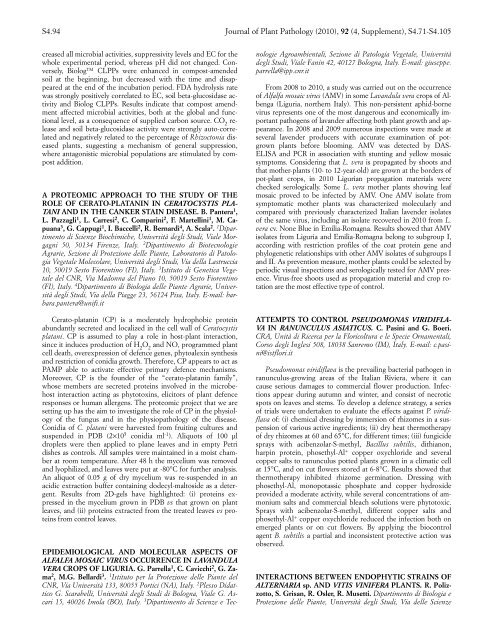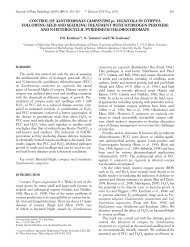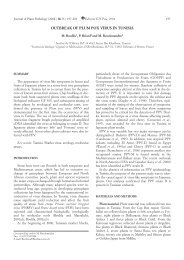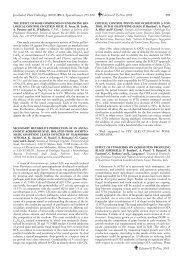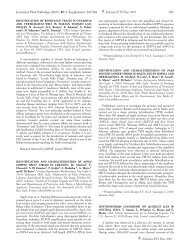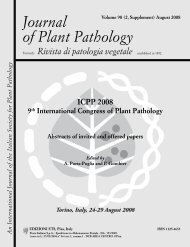Journal of Plant Pathology (2010), 92 (4, Supplement ... - Sipav.org
Journal of Plant Pathology (2010), 92 (4, Supplement ... - Sipav.org
Journal of Plant Pathology (2010), 92 (4, Supplement ... - Sipav.org
Create successful ePaper yourself
Turn your PDF publications into a flip-book with our unique Google optimized e-Paper software.
S4.94 <strong>Journal</strong> <strong>of</strong> <strong>Plant</strong> <strong>Pathology</strong> (<strong>2010</strong>), <strong>92</strong> (4, <strong>Supplement</strong>), S4.71-S4.105<br />
creased all microbial activities, suppressivity levels and EC for the<br />
whole experimental period, whereas pH did not changed. Conversely,<br />
Biolog CLPPs were enhanced in compost-amended<br />
soil at the beginning, but decreased with the time and disappeared<br />
at the end <strong>of</strong> the incubation period. FDA hydrolysis rate<br />
was strongly positively correlated to EC, soil beta-glucosidase activity<br />
and Biolog CLPPs. Results indicate that compost amendment<br />
affected microbial activities, both at the global and functional<br />
level, as a consequence <strong>of</strong> supplied carbon source. CO 2 release<br />
and soil beta-glucosidase activity were strongly auto-correlated<br />
and negatively related to the percentage <strong>of</strong> Rhizoctonia diseased<br />
plants, suggesting a mechanism <strong>of</strong> general suppression,<br />
where antagonistic microbial populations are stimulated by compost<br />
addition.<br />
A PROTEOMIC APPROACH TO THE STUDY OF THE<br />
ROLE OF CERATO-PLATANIN IN CERATOCYSTIS PLA-<br />
TANI AND IN THE CANKER STAIN DISEASE. B. Pantera 1 ,<br />
L. Pazzagli 1 , L. Carresi 2 , C. Comparini 2 , F. Martellini 1 , M. Capuana<br />
3 , G. Cappugi 1 , I. Baccelli 2 , R. Bernardi 4 , A. Scala 2 . 1 Dipartimento<br />
di Scienze Biochimiche, Università degli Studi, Viale M<strong>org</strong>agni<br />
50, 50134 Firenze, Italy. 2 Dipartimento di Biotecnologie<br />
Agrarie, Sezione di Protezione delle Piante, Laboratorio di Patologia<br />
Vegetale Molecolare, Università degli Studi, Via della Lastruccia<br />
10, 50019 Sesto Fiorentino (FI), Italy. 3 Istituto di Genetica Vegetale<br />
del CNR, Via Madonna del Piano 10, 50019 Sesto Fiorentino<br />
(FI), Italy. 4 Dipartimento di Biologia delle Piante Agrarie, Università<br />
degli Studi, Via della Piagge 23, 56124 Pisa, Italy. E-mail: barbara.pantera@unifi.it<br />
Cerato-platanin (CP) is a moderately hydrophobic protein<br />
abundantly secreted and localized in the cell wall <strong>of</strong> Ceratocystis<br />
platani. CP is assumed to play a role in host-plant interaction,<br />
since it induces production <strong>of</strong> H 2 O 2 and NO, programmed plant<br />
cell death, overexpression <strong>of</strong> defence genes, phytoalexin synthesis<br />
and restriction <strong>of</strong> conidia growth. Therefore, CP appears to act as<br />
PAMP able to activate effective primary defence mechanisms.<br />
Moreover, CP is the founder <strong>of</strong> the “cerato-platanin family”,<br />
whose members are secreted proteins involved in the microbehost<br />
interaction acting as phytotoxins, elicitors <strong>of</strong> plant defence<br />
responses or human allergens. The proteomic project that we are<br />
setting up has the aim to investigate the role <strong>of</strong> CP in the physiology<br />
<strong>of</strong> the fungus and in the physiopathology <strong>of</strong> the disease.<br />
Conidia <strong>of</strong> C. platani were harvested from fruiting cultures and<br />
suspended in PDB (2×10 5 conidia ml -1 ). Aliquots <strong>of</strong> 100 µl<br />
droplets were then applied to plane leaves and in empty Petri<br />
dishes as controls. All samples were maintained in a moist chamber<br />
at room temperature. After 48 h the mycelium was removed<br />
and lyophilized, and leaves were put at -80°C for further analysis.<br />
An aliquot <strong>of</strong> 0.05 g <strong>of</strong> dry mycelium was re-suspended in an<br />
acidic extraction buffer containing dodecyl-maltoside as a detergent.<br />
Results from 2D-gels have highlighted: (i) proteins expressed<br />
in the mycelium grown in PDB vs that grown on plant<br />
leaves, and (ii) proteins extracted from the treated leaves vs proteins<br />
from control leaves.<br />
EPIDEMIOLOGICAL AND MOLECULAR ASPECTS OF<br />
ALFALFA MOSAIC VIRUS OCCURRENCE IN LAVANDULA<br />
VERA CROPS OF LIGURIA. G. Parrella 1 , C. Cavicchi 2 , G. Zama<br />
2 , M.G. Bellardi 3 . 1 Istituto per la Protezione delle Piante del<br />
CNR, Via Università 133, 80055 Portici (NA), Italy. 2 Plesso Didattico<br />
G. Scarabelli, Università degli Studi di Bologna, Viale G. Ascari<br />
15, 40026 Imola (BO), Italy. 3 Dipartimento di Scienze e Tec-<br />
nologie Agroambientali, Sezione di Patologia Vegetale, Università<br />
degli Studi, Viale Fanin 42, 40127 Bologna, Italy. E-mail: giuseppe.<br />
parrella@ipp.cnr.it<br />
From 2008 to <strong>2010</strong>, a study was carried out on the occurrence<br />
<strong>of</strong> Alfalfa mosaic virus (AMV) in some Lavandula vera crops <strong>of</strong> Albenga<br />
(Liguria, northern Italy). This non-persistent aphid-borne<br />
virus represents one <strong>of</strong> the most dangerous and economically important<br />
pathogens <strong>of</strong> lavander affecting both plant growth and appearance.<br />
In 2008 and 2009 numerous inspections were made at<br />
several lavender producers with accurate examination <strong>of</strong> potgrown<br />
plants before blooming. AMV was detected by DAS-<br />
ELISA and PCR in association with stunting and yellow mosaic<br />
symptoms. Considering that L. vera is propagated by shoots and<br />
that mother-plants (10- to 12-year-old) are grown at the borders <strong>of</strong><br />
pot-plant crops, in <strong>2010</strong> Ligurian propagation materials were<br />
checked serologically. Some L. vera mother plants showing leaf<br />
mosaic proved to be infected by AMV. One AMV isolate from<br />
symptomatic mother plants was characterized molecularly and<br />
compared with previously characterized Italian lavender isolates<br />
<strong>of</strong> the same virus, including an isolate recovered in <strong>2010</strong> from L.<br />
vera cv. None Blue in Emilia-Romagna. Results showed that AMV<br />
isolates from Liguria and Emilia-Romagna belong to subgroup I,<br />
according with restriction pr<strong>of</strong>iles <strong>of</strong> the coat protein gene and<br />
phylogenetic relationships with other AMV isolates <strong>of</strong> subgroups I<br />
and II. As prevention measure, mother plants could be selected by<br />
periodic visual inspections and serologically tested for AMV presence.<br />
Virus-free shoots used as propagation material and crop rotation<br />
are the most effective type <strong>of</strong> control.<br />
ATTEMPTS TO CONTROL PSEUDOMONAS VIRIDIFLA-<br />
VA IN RANUNCULUS ASIATICUS. C. Pasini and G. Boeri.<br />
CRA, Unità di Ricerca per la Floricoltura e le Specie Ornamentali,<br />
Corso degli Inglesi 508, 18038 Sanremo (IM), Italy. E-mail: c.pasini@istflori.it<br />
Pseudomonas viridiflava is the prevailing bacterial pathogen in<br />
ranunculus-growing areas <strong>of</strong> the Italian Riviera, where it can<br />
cause serious damages to commercial flower production. Infections<br />
appear during autumn and winter, and consist <strong>of</strong> necrotic<br />
spots on leaves and stems. To develop a defence strategy, a series<br />
<strong>of</strong> trials were undertaken to evaluate the effects against P. viridiflava<br />
<strong>of</strong>: (i) chemical dressing by immersion <strong>of</strong> rhizomes in a suspension<br />
<strong>of</strong> various active ingredients; (ii) dry heat thermotherapy<br />
<strong>of</strong> dry rhizomes at 60 and 65°C, for different times; (iii) fungicide<br />
sprays with acibenzolar-S-methyl, Bacillus subtilis, dithianon,<br />
harpin protein, phosethyl-Al + copper oxychloride and several<br />
copper salts to ranunculus potted plants grown in a climatic cell<br />
at 15°C, and on cut flowers stored at 6-8°C. Results showed that<br />
thermotherapy inhibited rhizome germination. Dressing with<br />
phosethyl-Al, monopotassic phosphate and copper hydroxide<br />
provided a moderate activity, while several concentrations <strong>of</strong> ammonium<br />
salts and commercial bleach solutions were phytotoxic.<br />
Sprays with acibenzolar-S-methyl, different copper salts and<br />
phosethyl-Al + copper oxychloride reduced the infection both on<br />
emerged plants or on cut flowers. By applying the biocontrol<br />
agent B. subtilis a partial and inconsistent protective action was<br />
observed.<br />
INTERACTIONS BETWEEN ENDOPHYTIC STRAINS OF<br />
ALTERNARIA sp. AND VITIS VINIFERA PLANTS. R. Polizzotto,<br />
S. Grisan, R. Osler, R. Musetti. Dipartimento di Biologia e<br />
Protezione delle Piante, Università degli Studi, Via delle Scienze


